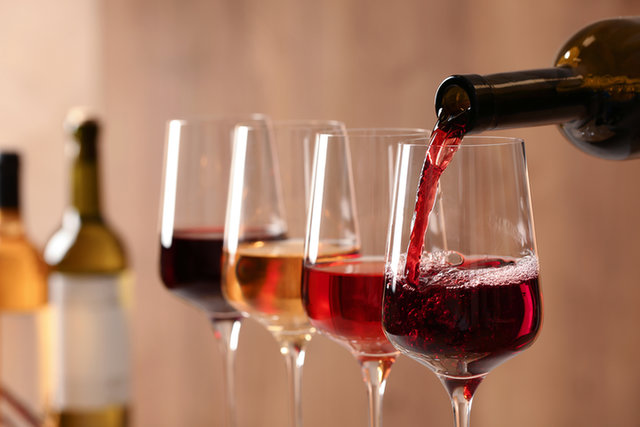From YOLO to NOLO:
The buzz on low alcohol beverages
The NOLO (low or no alcohol) beverage movement is making a big splash in the industry. Consumers expect all of the fun associated with alcoholic beverages, but fewer consequences and maybe even a few benefits.
Cocktails are fun and tasty, but many are heavy on the alcohol. And not everyone wants the heavy buzz from alcohol.
For example, on my 40th birthday my husband took me to Atera in NYC for a very fancy, 22- the two-Michelin star Tribeca tasting counter. When given the option to add a wine pairing for each dish or to add a "temperance pairing", a non-alcoholic selection of artisan drinks, I opted for temperance. The case against the wine pairings was pretty simple: there's just too much alcohol. I wanted to savor and fully enjoy each dish without the alcohol haze.
I’m not alone. Consumers are more conscious of their physical and mental health than they have ever been, and this has driven the fall in alcohol consumption we are seeing, especially among young people. The trend can be seen in social movement events such as “Sober for October” and “Dry January”.
"NOLO" alcohol (no- and low- alcohol) was predicted to be one of the driving trends of 2020. And the non-alcoholic beverage category has experienced significant growth over the past few years, with Nielsen naming low and no-alcohol options as a top alcohol trend for 2020. Consumers want to drink responsibly, enjoying a social lifestyle without taking on a calorific or boozy load.
Alcohol sales may have peaked during the COVID-19 lockdown, but wider industry trends suggest a move towards more health-conscious NOLO alcohol beverages and expanded offerings. This was amplified by social gathering restrictions in the wake of Covid-19.
People are drinking differently, socializing differently—for many, the ritualistic demands of being in a bar isn’t a driving force anymore. There’s a developing distaste for getting drunk, especially in work environments (work meals, conferences, and events). And then there are also the repercussions. Hangovers simply don’t work out well and people start to wonder: “Why does drinking have to be this way?” and “Does it really have to make us feel this horrible?”
As it turns out: No, it doesn’t.

What is “low alcohol”?
But what exactly is an alcohol-free beer or cocktail? This may sound like a stupid question, but it is unfortunately more complicated than you’d expect.
‘Low-alcohol drinks’ technically refers to drinks which have an ‘alcoholic strength by volume’ (ABV) between 0.05 and 1.2%. ‘Reduced alcohol’ refers to a drink with an alcohol content lower than the average strength of a drink. This means that wine with an ABV strength of 5.5%, is called a reduced alcohol wine, as opposed to a low-alcohol wine.
A non-alcoholic drink isn’t the same as an alcohol-free one. In most of the European Union, and the US, a beer is considered alcohol-free it if contains less than 0.5% alcohol. Whereas in the UK a beer brewed within the country can only be labelled alcohol-free if it has less than 0.05% alcohol. If a UK brew is 0.5% it can only say it is "de-alcoholised". As that is apparently off-putting to drinkers, most British brewers chose to say "low alcohol" instead. But, 0.5% beers from abroad can call themselves alcohol free when sold in the UK - they don't have to amend their labels.
Cocktails without alcohol go by many names – mocktails, zero-proof or spirit-free. This paired with the addition of low alcohol options has created the NOLO category.

Why?
There is an increase in demand for lighter, healthier drinks from many different types of consumers. From the designated driver, to the health-conscious Millennial, or the sober-curious or the person who has to be up early in the morning.
Generational shift in attitudes towards alcohol have helped to drive the trend. As with many of today’s consumer trends, Millennials are driving the mindful drinking movement, with a less rigid approach to alcohol. They are happy to drink it when they are in the mood, but also happy to do without it. Seemingly rooted in the growing desire for “wellness” in an unwell world, millennials are drinking less -- and more thoughtfully -- than their Gen X and Boomer counterparts. The drop in numbers of young people drinking suggested a shift in attitudes towards alcohol possibly due to increased awareness of the health risks of alcohol, as well as changes in the way young people spend their leisure time. They are more conscious of what they put in their bodies. They read the labels, like to know where things come from, and like to know who's behind the product. One in three young adults are cutting down their alcohol consumption, and a record 23% are choosing complete abstinence, according to research by the Society of Independent Brewers.
The health benefits of switching to low alcohol or non-alcoholic drinks are clear. In the short term, you’re more likely to get a better night’s sleep; feel fresher in the morning and have a more productive day at work as a result. What’s more, some lighter products are lower in calories, so waistlines benefit too. The health and wellness preference isn’t a new focus for consumers, but it is one that’s starting to shape behaviors — evenings out and other drinking occasions.
Recently, the NOLO ABV movement has spurred a fundamental shift in consumer drinking habits and consumer behavior that can be seen in the data. A Bon Appétit survey, revealed low- and no-alcohol products are expected to grow 32% between 2018 and 2022 (pre-Covid numbers) and that non-alcoholic beverages are worth $7 billion more at retail than they were four years ago . This shift is largely fueled by not the complete non-drinker, but rather the sober-curious—drinkers who don’t want to completely abstain, but still want to pursue a healthier lifestyle. They preer lower-proof drinks, cutting down overall alcohol consumption, and participate in breaks from alcohol (like Sober October and Dry January).

How?
One of the major problems in the low-ABV world was that products tended to be underwhelming. Often considered to just be watered down, whispers of their higher proof counterparts —not usually something consumers would sip neat.
But the NOLO, “sober curious” movement is turning the tables on what a typical night out looks like. As well as what should be expected of NOLO beverages. Those seeking a night on the town are seeking experiences and premium offerings in the same way that alcohol drinkers are—a bar experience but without the buzz.
NOLO beverages need to be more experience driven. People are more likely to purchase a product or service after they come across it in an exciting, engaging setting. But in order to make a genuine impact in this growing market, experiences may be among the most effective brand-building methods.
Despite how dim this might sound for bars and restaurants, demand for beverages with no and low-alcohol content is rising. While alcohol consumption has been relatively flat over the past year, this has pushed many establishments to get more creative in their efforts to attract and engage consumers. For restaurants, bars and other establishments serving alcohol, having to get creative with drink offerings has become a necessity to meet the needs of consumers opting for booze-free nightlife experiences. Near-beers, premium soft drinks, mocktails, low- and non-alcoholic options, kombuchas and botanical tinctures all offer a wealth of opportunity for on-premise establishments to experiment with and promote to consumers.
It’s vital for brands to focus on creating a quality experience; great experiences linger long in the memory. Good strategy is essential, and most of it comes down to creating a context and environment where consumer will most naturally engage, whether that be time of day, location or scale of activity. But NOLO beverages can be more than just a fun beverage experience. The health and wellness trend fueling the NOLO category pushes demand for not only more variety, better tasting and higher quality products, but also added benefits of NOLO beverages. For example, beverages may be able to add to the consumer’s health and wellness regime through the addition of botanicals and super foods, probiotics such as kombucha, and active ingredients (such as CBD) that drive additional health and wellness benefits. These consumers are seeking NOLO cocktails made with natural ingredients, or with a ‘health halo’, such as matcha and herbal infusions, fresh berries and fruits, and using spices and herbs in homemade tonics and tinctures to deliver a big flavor in a more ‘natural’ and beneficial way.

But...
Drinkers have no reason to worry: Alcohol isn’t going anywhere. If anything, the drinking standards are being raised across the board. In the last few decades, cocktails went from vodka tonics to fancier cocktails. The quality of spirits, beers, and wines has continued to rise with more interest in local or craft breweries and distilleries.
Consumers are, overall, drinking better booze. And therefore, it’s only natural that NOLO or non-drinkers are getting better options, too.
ABOUT THE AUTHOR
Dr. Michelle Niedziela (PhD) is a behavioral neuroscience expert in neuropsychology, psychology and consumer science. Experienced from academia (Monell Chemical Senses Center) and industry (Johnson & Johnson, Mars Chocolate) in R&D of innovation technologies and methodologies for consumer research. As Scientific Director, HCD Michelle focuses on integrating applied consumer neuroscience tools with traditional methods used to measure consumer response.





